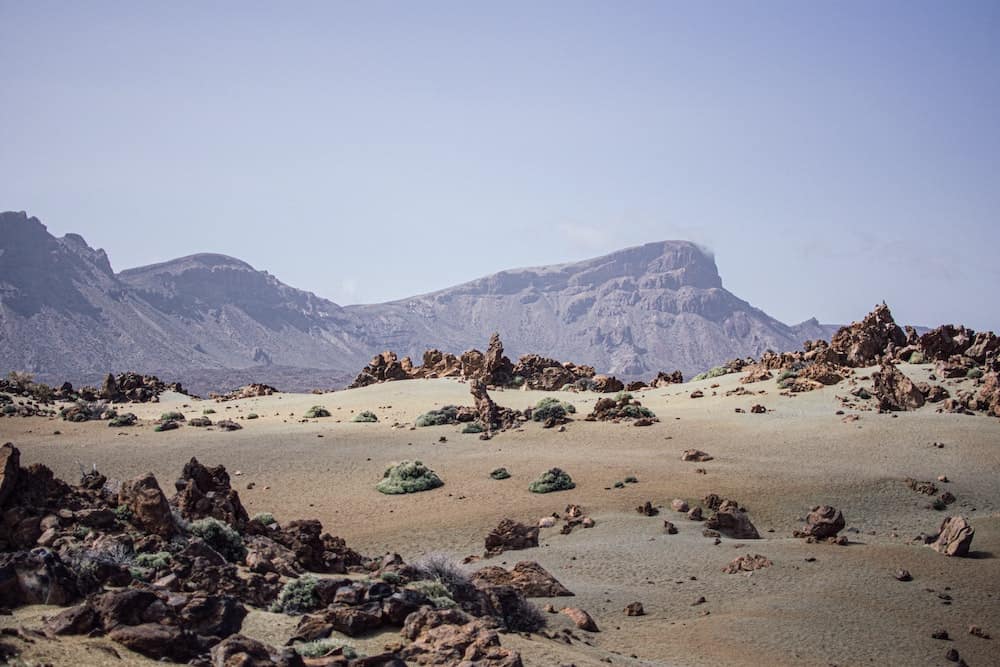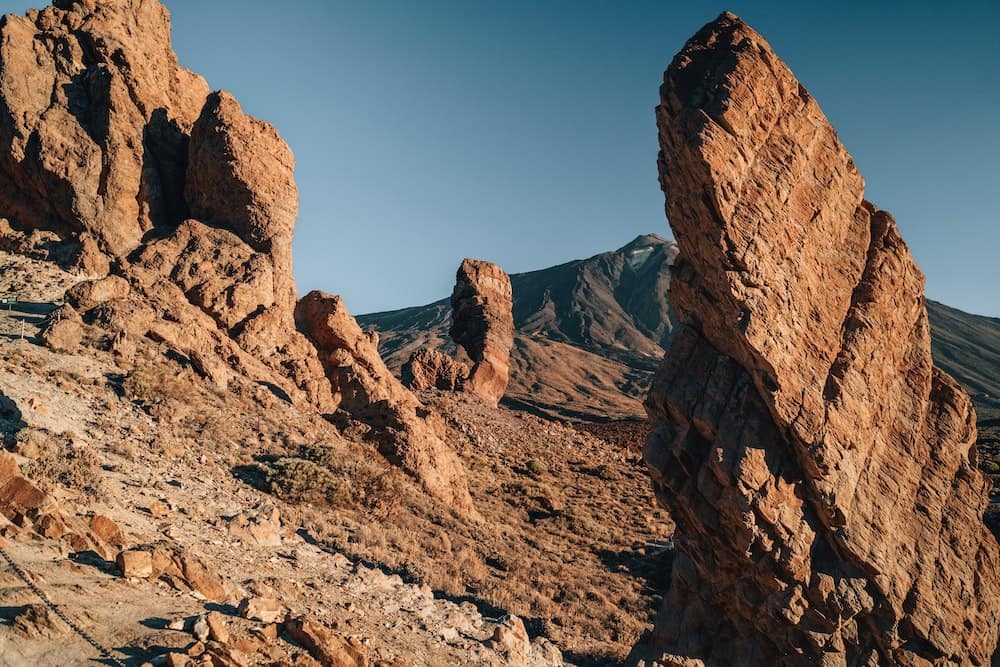Visit national Park El Teide
Disclosure: Bear in mind that some of the links in this post are affiliate links and if you go through them to make a purchase we will earn a commission at no additional cost to you. We chose these companies / hotels because of their quality and not because of the commission we receive from your purchases.
In the heart of the island of Tenerife there is one of the most majestic and impressive natural areas in Europe and in the world. We are talking about the national park El Teide. In this park and in the Cañadas you can walk endlessly. It is truly a unique place that you should not miss. You will find landscapes that seem to come from another planet. Walk among volcanic lava and feel tiny in these impressive surroundings that UNESCO declared a World Heritage Site in 2007.

National Park El Teide is undoubtedly the most characteristic place of Tenerife. On the one hand, here you can find the most beautiful examples of Mediterranean mountain vegetation above 2,000 meters (6561 ft). On the other hand, it is one of the most spectacular areas of volcanic activity in the world, and of course the most striking in the Canary Islands. The area around the main craters of Pico Viejo and el Teide in Tenerife is almost 20,000 hectares (49420 acres), making the park the largest protected natural area in the Canary Islands. You can take short, marked walks (and dances) through the volcanic landscape.
The literal highlight of the park is Mount Teide with its summit at 3,718 meters (12198 ft), the highest peak in Spain and the third highest volcano in the world. This volcano was created by an eruption about 150,000 years ago and last erupted in 1909. The crater is a spectacular 48 kilometres (29 miles) in circumference and resembles the red planet Mars in many ways. There is no uniform landscape in this park, but you will find many variations in the volcanic elements. The hundreds of cones, lava flows and caves make the scientific and scenic importance of El Teide huge. Not to mention the rich fauna and flora, with a large number of endemic species, which live exclusively in the Canary Islands or even only in this park.
Touring
Touring this area, even if only by car, is a treat for the eyes. The landscape is impressive wherever you look. To get to know the park better, it is best to drive up one side of the mountain and down another. 
You get the biggest contrast between the northern and southern roads. Las Cañadas del Teide form a gigantic caldeira (volcanic cauldron) of about 17 km diameter (10.5 miles) on which the Pico del Teide is situated. The snow on the summit alongside the hardened lava flows flowing down the slopes form a unique combination that you could gaze at for days.
The El Teide cable car
One of the most exciting experiences in the National Park is a ride on the cable car. The base station is at 2,356m (7729 ft) and the end station at 3,555m (11633 ft). The ride takes about 8 minutes, an immersive experience. Once at the top, you can enjoy exceptional views at the lookout point. This is breathtakingly beautiful.
The cable car is open daily from 9:00 am to 5:00 pm. It is best to arrange this in advance and online. If you really want to go to the top you can climb from the platform to the top of volcanic crater. This is a tough hike in the thin air lasting about an hour. The descent is easier and takes less than half an hour. You need a permit for this hike: Permiso de Acceso. For more information, visit the website of Reservas Parques Nacionales.
Hiking
There are 9 marked hiking trails to choose from at National Park El Teide. These routes vary in distance and difficulty. They are all clearly marked and can be easy or challenging. The paths on these routes consist mainly of loose stones and sand, so it is advisable to wear your walking shoes instead of flip-flops.
The route around the Roques de García is the most popular route in the park. It is a must see, but it can be crowded. It is recommended to start early in the morning or late in the afternoon so you can avoid the many buses with tourists. Starting and ending point of this walk is The Mirador de la Ruleta, a very nice viewpoint. There are many more walks, such as the walk the 7 Cañadas of 18 km (11 miles). This walking route offers a great diversity of beautiful places that seem to be abandoned from everything and everyone.
Cycling at Teide National Park
Besides hiking, it is also very nice to discover the Natural Park of El Teide by bike. You can do this independently by renting a bike, a mountain bike or an e-bike. The price is about €15 per day for a bicycle/mountain bike and about €20 per day for renting an e-bike. Keep in mind that a bicycle tour consists of climbs and descents and only occasionally flat areas. An e-bike is therefore not an unnecessary luxury.
Look at the stars
Few places in the world have such an extraordinary landscape with scientific facilities of the highest level. The installations of the IAC (Canary Islands Astrophysical Institute) are among the most important in the world and you can visit them and discover the secrets of the universe up close by contacting the company Volcano Life, which offers guided tours in Spanish, English and German. You can also go to their website. If you already felt small in the National Park, wait until you learn about the mysteries of the universe and discover its true greatness.
Is it safe to visit this volcano area?
The last eruption of the Pico El Teide was in 1909. If you look at the history this volcano erupts about once every 100 years. In recent years there has been a sharp increase in seismic (earthquake) activity in the volcano. So it is rumbling under the surface of the earth. You can also see (and smell!) this from the sulfate vapours coming from the crater.
History also teaches us the longer ago the eruption, the more violent the next one becomes. That is why el Teide is on the list of the 16 most dangerous volcanoes on earth.
So is it risky to visit this volcanic area? No. The observatory of el Teide which, together with the Instituto de Astrofisica de Canarias, monitors all the activity in the volcano day and night. They will raise the alarm in time if necessary.
How to get there
The national park is easily accessible by car. The roads that go through the park are equipped with parking spaces in several places. These spots are mainly located at beautiful viewpoints and at places from where you can start a walk through the park. Weather conditions in the park can include strong winds that sometimes carry a lot of dust, bright sunshine and lower temperatures. Take this into account when visiting the park.
By bus:
From Puerto de la Cruz, line 348.
From Costa Adeje, line 342.
By car:
From the north on the TF-21 La Orotava-Granadilla or the TF-24 La Laguna-El Portillo.
From the south on the TF-21.
From the west by the TF-38 Boca Tauce-Chío.
Where is the best place to stay?
One of the best sustainable places to stay on the island is called the Canary Bio Hostel. It is just 30 km (18.8 miles) from the Pico El Teide and just 2 km (1.2 miles) from the ocean. A perfect location to explore the entire island and everything about our stay was great. The location is very well connected by bus and we absolutely loved the view from the terrace.

All facilities were working perfectly, with clear instructions about how everything works in the kitchen. We also bought some vegetables from their organic garden. This hostel combines tourism and ecological responsibility which is a great idea for this beautiful island and planet.
There is only a few rooms which makes it quiet and intimate. Be sure to book on time.
The best months to visit El Teide National Park
If there is a destination with an almost perfect climate, it is Tenerife. This pleasant destination offers spring-like to summer weather almost every day. With afternoon temperatures on the south coast usually between 22 and 29 degrees Celsius (71-84 °F) you can expect pleasant temperatures year round. The north coast is less warm and has fewer sun hours than the sun-drenched southern regions.
Even during the coolest months, there are plenty of days where the weather is great for spending time at the beach. What you do notice during the local winter months (December- March) is that it cools down faster at the end of the day. The sun shines a bit less and there is an increased chance of precipitation. Those who want to enjoy sunnier weather in Tenerife should fly to Tenerife in the period from May to mid-October. This is the period with the highest temperatures, most sun and the least rain. However, in the months of July and August (high season) there is a chance of serious heat, due to the hot Saharan air coming from the east. This phenomenon often appears suddenly and then lasts a few days at most. Click here for more climate details.